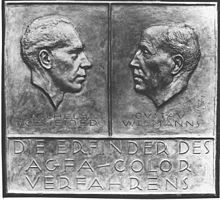Wilhelm Schneider (chemist)
Wilhelm Schneider (born December 31, 1900 in Naila ; † August 2, 1980 in Freiburg im Üechtland ) was a German chemist and co-developer of the Agfa-Color process .
Life
The son of a businessman grew up in Munich, where he attended secondary school and, after graduating from high school, studied chemistry at the Technical University of Munich from 1921 to 1924 . After graduating as a graduate engineer, he received his doctorate in chemistry under August Albert (1882–1951) in 1925. After completing his doctorate, Schneider was employed as a scientific assistant at the laboratory for applied chemistry at the TH Munich for a year.
In 1929 Schneider joined the technical and scientific department of Agfa Filmfabrik Wolfen , headed by Gustav Wilmanns . There he initially dealt with the further development of black and white films, in particular with antihalation dyes. His discovery at the beginning of 1932 that dyes can be incorporated into layers of gelatin in such a way that they cannot be washed off if they had chemical groups known from cotton dyeing, the basis for the development of color films was laid.
A first patent was granted on February 25, 1932. The decisive patent with which “substantive” color couplers were protected has been registered since April 11, 1935. This process, which was further improved in the following years, received the Grand Prix at the World Exhibition in Paris in 1937 . Wilmanns and Schneider were simultaneously awarded the gold medal at the world exhibition. After Wilmanns' retirement in 1940, Schneider became his successor and headed the color film development project, which included photography as well as color feature film. As early as 1941, the film " Women Are Better Diplomats " was made with Agfacolor film material. The premiere of the German color film, for which Schneider and his team had laid the essential technical basis, is often seen as the performance of the film Die goldene Stadt on October 3, 1942 as part of the “Color and Film” conference.
After the collapse of the “Third Reich” Wolfen fell under Soviet sovereignty. Schneider initially moved to Coburg and worked temporarily in Munich. A return to Wolfen, as he intended, was not approved, however, as his house in Dessau had been expropriated and its return was refused by the Soviet administration. In 1946 Schneider then moved to Friborg in Switzerland, where he became technical director at the Tellko film factory. Schneider was married to Ingeborg Melchior from 1929 to 1965 and had two daughters.
Honors
- 1935: Gold medal of the world exhibition together with Gustav Wilmanns
- 1941: Presentation of the Leica camera No. 350,000
- 1942: Ufa bronze plaque in Potsdam-Babelsberg for the development of color cinema films
- 1946: Presentation of the Leica camera 400,000
- 1952: Gold medal from the Vienna Photography Society
- In Bitterfeld-Wolfen OT Wolfen a street bears his name
Fonts
- Schneider, Wilhelm (1925): About oxazoles and their mercuration products. Inaugural dissertation to obtain a doctorate. Techn. Hochsch. Munich.
- Schneider, Wilhelm (1944): Color photography, European study folders, Ed .: The Academic Cultural Exchange and the Technical University of Munich
- Schneider, Wilhelm (Febr. 1946): Guide to the Agfacolor process for everyone FIATFINALREPORT 976, (summary of his main publications)
literature
Gill, Manfred; Walther, Werner; Finger, Ehrhard: On the 100th birthday of Wilhelm Schneider, 2000, Die Filmfabrik Wolfen, From History, Issue 8, Ed .: Industrie- und Filmmuseum Wolfen eV, 2000
Finger, Ehrhard: Wilhelm Schneider, "Father" of the Agfacolor-Neu-Procedure, Dessau Calendar 2015, Ed .: Stadt Dessau-Rosslau, Stadtarchiv, 59th year, pp. 70–79
Individual evidence
- ↑ a b Leica Camera Lists - List of special gifts p.15 ( Memento of the original dated October 4, 2013 in the Internet Archive ) Info: The archive link was inserted automatically and has not yet been checked. Please check the original and archive link according to the instructions and then remove this notice. (List of Leica cameras and lenses, accessed April 25, 2011; PDF; 4.7 MB)
| personal data | |
|---|---|
| SURNAME | Schneider, Wilhelm |
| BRIEF DESCRIPTION | German chemist and co-developer of the Agfa-Color process |
| DATE OF BIRTH | December 31, 1900 |
| PLACE OF BIRTH | Naila |
| DATE OF DEATH | 2nd August 1980 |
| Place of death | Freiburg in Üechtland |
